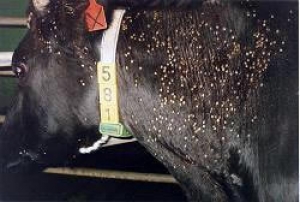Procedure for husbandry dairy calves and cows
Tick control for dairy cattle

On this page:
- Heifer program
- Strategic control program
- Other ticks important to heifers in Queensland
- Using acaricides
Heifer program
Control of cattle ticks in heifers involves the same program as the milking herd. An individual strategic control program should be designed for the specific conditions on each farm. The heifers should be treated at the same time as the milking herd to achieve maximum tick control. Strategic control programs are designed to be effective by taking into account the ticks' breeding cycle, specific climatic conditions and property tick history. The cattle tick has a three-week period on the cattle. Larval ticks attaching to cattle after a treatment (or after any effective treatment residues are gone) will engorge as adults and start to drop off the cattle onto the pasture in approximately three weeks. If all ticks on the cattle are treated before the engorged ticks drop, most ticks will be killed and not survive to lay eggs, which breaks the tick life cycle and reduces tick numbers in the paddocks and on the cattle.
An effective tick control program requires a strategy that gives maximum control with the least number of treatments to reduce the risk of resistance and reduce the chemical residue levels in milk and in the environment.
Strategic control program
The success of a tick control program will depend on:
- using a chemical that effectively kills ticks on the heifers properly and safely and as directed
- having adequate facilities and equipment that will allow the safe and effective treatment of heifers. These facilities and equipment need to be maintained in working condition.
- developing an effective strategic program and adhering to the starting date and recommended treatment intervals.
Recommended control program
The recommended strategic control programs vary for the different areas of the state because of varying environmental conditions.
The general recommendation for South East Queensland is to dip or spray six times at three-week intervals commencing in October. The number of treatments and starting date varies for different areas depending on the tick population response to the environmental conditions. In some areas of Queensland, one or two treatments are also required in autumn. Effective pour-ons can also be used in strategic control programs. The chemicals should be used in conjunction with management measures such as pasture rotation.
The use of tick fever vaccination is recommended in conjunction with any strategic tick control program. Avoid chemical residue problems by reading the product label carefully and strictly adhering to withholding periods.
Follow safety precautions
Always read the label carefully and use the products only as directed. This is especially important in heifers as mistakes may lead to overdosing with the chemicals.
Follow all safety instructions for the handling of chemicals and the disposal of unwanted chemicals and containers.
Other ticks important to heifers in Queensland
Scrub or paralysis ticks (Ixodes holocyclus)
Scrub ticks are found mostly in higher rainfall areas and will attach to most animals. These ticks produce a potentially fatal toxin which may cause paralysis and death in calves and weaners. Young animals are particularly susceptible but survival after exposure to this toxin may allow some development of resistance.
The scrub tick has a different life cycle to the cattle tick and does not stay attached to the one host. Because scrub ticks attach and can rapidly cause paralysis, close observation and treatment is usually the most effective control option.
New Zealand cattle ticks (Haemaphysalis longicornis)
These ticks are found in higher rainfall coastal areas. Numbers can build up rapidly in favourable seasons and can cause losses in production. New Zealand cattle ticks do not stay attached to one host so require a different strategic treatment programme to cattle ticks.
Using acaricides
Using the cheaper acaricides ($0.50-$1.50 per head) alone may appear to be the most economic control measure. Long term however, as resistance inevitably develops in ticks to these commonly used acaricides, the more expensive macrocyclic lactones (ML) will be necessary to control ticks e.g. ML acaricides cost $0.60-$6 per head depending on body weight (approximately $600 per treatment for a 100-cow herd).























